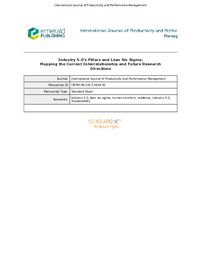Por favor, use este identificador para citar o enlazar este ítem:
https://hdl.handle.net/11000/34436Registro completo de metadatos
| Campo DC | Valor | Lengua/Idioma |
|---|---|---|
| dc.contributor.author | Mira-Solves, Ignacio | - |
| dc.contributor.author | Cuevas López de Baró, César | - |
| dc.contributor.author | Verdu-Jover, Antonio J | - |
| dc.contributor.other | Departamentos de la UMH::Estudios Económicos y Financieros | es_ES |
| dc.date.accessioned | 2025-01-12T18:08:59Z | - |
| dc.date.available | 2025-01-12T18:08:59Z | - |
| dc.date.created | 2024 | - |
| dc.identifier.citation | International Journal of Productivity and Performance Management | es_ES |
| dc.identifier.issn | 1758-6658 | - |
| dc.identifier.issn | 1741-0401 | - |
| dc.identifier.uri | https://hdl.handle.net/11000/34436 | - |
| dc.description.abstract | Purpose In the evolving landscape of Industry 5.0 (I5.0), which emphasises sustainability, human-centricity and resilience, mapping the current interrelationship and future research directions, the role of Lean Six Sigma (LSS) methodology remains underexplored. Our study addresses this gap by examining the potential of LSS to support I5.0 while identifying areas for further investigation. Design/methodology/approach This study's multifaceted approach, which includes systematic literature review (SLR), bibliographic network analysis (BNA) and expert validation (EV), provides a holistic exploration of the interaction between LSS and I5.0 as the basis for well-founded conclusions. Findings The analysis yields several valuable insights. Firstly, it demonstrates the absence of a direct link between LSS and I5.0. Secondly, the substantial body of literature analysed establishes connections between LSS and its pillars. Thirdly, the analysis identifies points of intersection, difference and similarity between LSS and I5.0, highlighting the potential of LSS to facilitate implementation of I5.0 through its proven methodologies, continuous improvement culture, risk management, error learning, human–machine collaboration and training and skill development. Originality/value This study pioneers the effort to realise the latent potential of LSS in the context of I5.0. Its systematic identification of the synergies between these paradigms fills a critical gap in the literature and gives policymakers, managers and researchers a guide for informed decision-making to maximise the benefits of I5.0 for individuals, companies, society and the planet. | es_ES |
| dc.format | application/pdf | es_ES |
| dc.format.extent | 27 | es_ES |
| dc.language.iso | eng | es_ES |
| dc.publisher | Emerald Publishing | es_ES |
| dc.rights | info:eu-repo/semantics/openAccess | es_ES |
| dc.rights | Attribution-NonCommercial-NoDerivatives 4.0 Internacional | * |
| dc.rights.uri | http://creativecommons.org/licenses/by-nc-nd/4.0/ | * |
| dc.subject | Industry 5.0 | es_ES |
| dc.subject | Lean Six Sigma | es_ES |
| dc.subject | sustainability | es_ES |
| dc.subject | human-centrism | es_ES |
| dc.subject | resilience | es_ES |
| dc.subject | Industry 4.0 | es_ES |
| dc.subject.other | CDU::3 - Ciencias sociales::33 - Economía | es_ES |
| dc.title | Industry 5.0's pillars and Lean Six Sigma: mapping the current interrelationship and future research directions | es_ES |
| dc.type | info:eu-repo/semantics/preprint | es_ES |
| dc.relation.publisherversion | https://doi.org/10.1108/IJPPM-08-2023-0404 | es_ES |

Ver/Abrir:
AAM 2024-Internacional Journal - industry 5.0.PDF
1,27 MB
Adobe PDF
Compartir:
 La licencia se describe como: Atribución-NonComercial-NoDerivada 4.0 Internacional.
La licencia se describe como: Atribución-NonComercial-NoDerivada 4.0 Internacional.
.png)